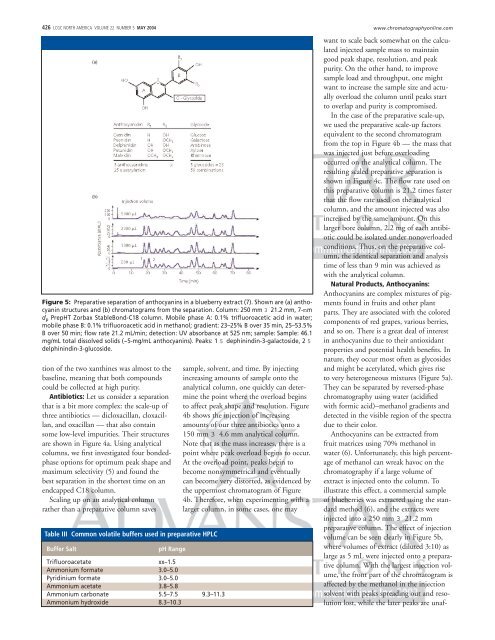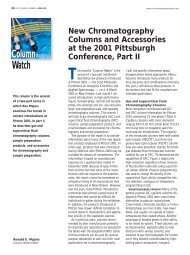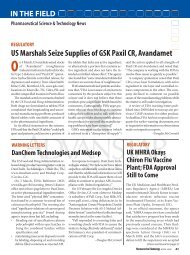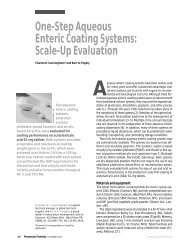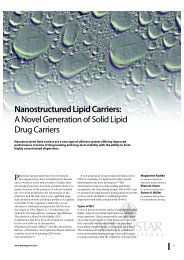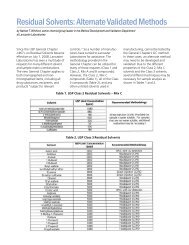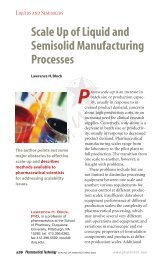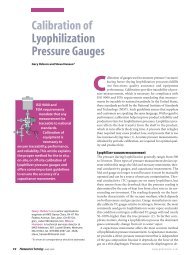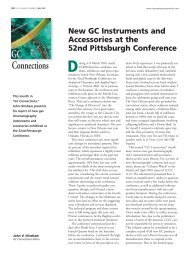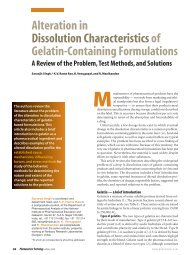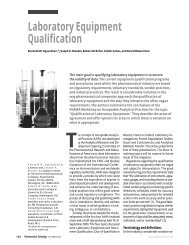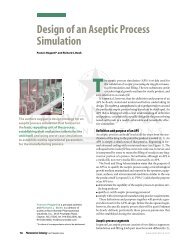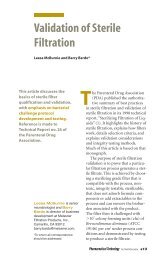The Role of the Column in Preparative HPLC - Chromatography ...
The Role of the Column in Preparative HPLC - Chromatography ...
The Role of the Column in Preparative HPLC - Chromatography ...
Create successful ePaper yourself
Turn your PDF publications into a flip-book with our unique Google optimized e-Paper software.
426 LCGC NORTH AMERICA VOLUME 22 NUMBER 5 MAY 2004 www.chromatographyonl<strong>in</strong>e.com<br />
Figure 5: <strong>Preparative</strong> separation <strong>of</strong> anthocyan<strong>in</strong>s <strong>in</strong> a blueberry extract (7). Shown are (a) anthocyan<strong>in</strong><br />
structures and (b) chromatograms from <strong>the</strong> separation. <strong>Column</strong>: 250 mm 3 21.2 mm, 7-mm<br />
d p PrepHT Zorbax StableBond-C18 column. Mobile phase A: 0.1% trifluoroacetic acid <strong>in</strong> water;<br />
mobile phase B: 0.1% trifluoroacetic acid <strong>in</strong> methanol; gradient: 23–25% B over 35 m<strong>in</strong>, 25–53.5%<br />
B over 50 m<strong>in</strong>; flow rate 21.2 mL/m<strong>in</strong>; detection: UV absorbance at 525 nm; sample: Sample: 46.1<br />
mg/mL total dissolved solids (~5-mg/mL anthocyan<strong>in</strong>s). Peaks: 1 5 deph<strong>in</strong><strong>in</strong>d<strong>in</strong>-3-galactoside, 2 5<br />
delph<strong>in</strong><strong>in</strong>d<strong>in</strong>-3-glucoside.<br />
tion <strong>of</strong> <strong>the</strong> two xanth<strong>in</strong>es was almost to <strong>the</strong><br />
basel<strong>in</strong>e, mean<strong>in</strong>g that both compounds<br />
could be collected at high purity.<br />
Antibiotics: Let us consider a separation<br />
that is a bit more complex: <strong>the</strong> scale-up <strong>of</strong><br />
three antibiotics — dicloxacillan, cloxacillan,<br />
and oxacillan — that also conta<strong>in</strong><br />
some low-level impurities. <strong>The</strong>ir structures<br />
are shown <strong>in</strong> Figure 4a. Us<strong>in</strong>g analytical<br />
columns, we first <strong>in</strong>vestigated four bondedphase<br />
options for optimum peak shape and<br />
maximum selectivity (5) and found <strong>the</strong><br />
best separation <strong>in</strong> <strong>the</strong> shortest time on an<br />
endcapped C18 column.<br />
Scal<strong>in</strong>g up on an analytical column<br />
ra<strong>the</strong>r than a preparative column saves<br />
Table III Common volatile buffers used <strong>in</strong> preparative <strong>HPLC</strong><br />
Buffer Salt<br />
pH Range<br />
Trifluoroacetate<br />
xx–1.5<br />
Ammonium formate 3.0–5.0<br />
Pyrid<strong>in</strong>ium formate 3.0–5.0<br />
Ammonium acetate 3.8–5.8<br />
Ammonium carbonate 5.5–7.5 9.3–11.3<br />
Ammonium hydroxide 8.3–10.3<br />
sample, solvent, and time. By <strong>in</strong>ject<strong>in</strong>g<br />
<strong>in</strong>creas<strong>in</strong>g amounts <strong>of</strong> sample onto <strong>the</strong><br />
analytical column, one quickly can determ<strong>in</strong>e<br />
<strong>the</strong> po<strong>in</strong>t where <strong>the</strong> overload beg<strong>in</strong>s<br />
to affect peak shape and resolution. Figure<br />
4b shows <strong>the</strong> <strong>in</strong>jection <strong>of</strong> <strong>in</strong>creas<strong>in</strong>g<br />
amounts <strong>of</strong> our three antibiotics onto a<br />
150 mm 3 4.6 mm analytical column.<br />
Note that as <strong>the</strong> mass <strong>in</strong>creases, <strong>the</strong>re is a<br />
po<strong>in</strong>t where peak overload beg<strong>in</strong>s to occur.<br />
At <strong>the</strong> overload po<strong>in</strong>t, peaks beg<strong>in</strong> to<br />
become nonsymmetrical and eventually<br />
can become very distorted, as evidenced by<br />
<strong>the</strong> uppermost chromatogram <strong>of</strong> Figure<br />
4b. <strong>The</strong>refore, when experiment<strong>in</strong>g with a<br />
larger column, <strong>in</strong> some cases, one may<br />
want to scale back somewhat on <strong>the</strong> calculated<br />
<strong>in</strong>jected sample mass to ma<strong>in</strong>ta<strong>in</strong><br />
good peak shape, resolution, and peak<br />
purity. On <strong>the</strong> o<strong>the</strong>r hand, to improve<br />
sample load and throughput, one might<br />
want to <strong>in</strong>crease <strong>the</strong> sample size and actually<br />
overload <strong>the</strong> column until peaks start<br />
to overlap and purity is compromised.<br />
In <strong>the</strong> case <strong>of</strong> <strong>the</strong> preparative scale-up,<br />
we used <strong>the</strong> preparative scale-up factors<br />
equivalent to <strong>the</strong> second chromatogram<br />
from <strong>the</strong> top <strong>in</strong> Figure 4b –– <strong>the</strong> mass that<br />
was <strong>in</strong>jected just before overload<strong>in</strong>g<br />
occurred on <strong>the</strong> analytical column. <strong>The</strong><br />
result<strong>in</strong>g scaled preparative separation is<br />
shown <strong>in</strong> Figure 4c. <strong>The</strong> flow rate used on<br />
this preparative column is 21.2 times faster<br />
that <strong>the</strong> flow rate used on <strong>the</strong> analytical<br />
column, and <strong>the</strong> amount <strong>in</strong>jected was also<br />
<strong>in</strong>creased by <strong>the</strong> same amount. On this<br />
larger bore column, 2.2 mg <strong>of</strong> each antibiotic<br />
could be isolated under nonoverloaded<br />
conditions. Thus, on <strong>the</strong> preparative column,<br />
<strong>the</strong> identical separation and analysis<br />
time <strong>of</strong> less than 9 m<strong>in</strong> was achieved as<br />
with <strong>the</strong> analytical column.<br />
Natural Products, Anthocyan<strong>in</strong>s:<br />
Anthocyan<strong>in</strong>s are complex mixtures <strong>of</strong> pigments<br />
found <strong>in</strong> fruits and o<strong>the</strong>r plant<br />
parts. <strong>The</strong>y are associated with <strong>the</strong> colored<br />
components <strong>of</strong> red grapes, various berries,<br />
and so on. <strong>The</strong>re is a great deal <strong>of</strong> <strong>in</strong>terest<br />
<strong>in</strong> anthocyan<strong>in</strong>s due to <strong>the</strong>ir antioxidant<br />
properties and potential health benefits. In<br />
nature, <strong>the</strong>y occur most <strong>of</strong>ten as glycosides<br />
and might be acetylated, which gives rise<br />
to very heterogeneous mixtures (Figure 5a).<br />
<strong>The</strong>y can be separated by reversed-phase<br />
chromatography us<strong>in</strong>g water (acidified<br />
with formic acid)–methanol gradients and<br />
detected <strong>in</strong> <strong>the</strong> visible region <strong>of</strong> <strong>the</strong> spectra<br />
due to <strong>the</strong>ir color.<br />
Anthocyan<strong>in</strong>s can be extracted from<br />
fruit matrices us<strong>in</strong>g 70% methanol <strong>in</strong><br />
water (6). Unfortunately, this high percentage<br />
<strong>of</strong> methanol can wreak havoc on <strong>the</strong><br />
chromatography if a large volume <strong>of</strong><br />
extract is <strong>in</strong>jected onto <strong>the</strong> column. To<br />
illustrate this effect, a commercial sample<br />
<strong>of</strong> blueberries was extracted us<strong>in</strong>g <strong>the</strong> standard<br />
method (6), and <strong>the</strong> extracts were<br />
<strong>in</strong>jected <strong>in</strong>to a 250 mm 3 21.2 mm<br />
preparative column. <strong>The</strong> effect <strong>of</strong> <strong>in</strong>jection<br />
volume can be seen clearly <strong>in</strong> Figure 5b,<br />
where volumes <strong>of</strong> extract (diluted 3:10) as<br />
large as 5 mL were <strong>in</strong>jected onto a preparative<br />
column. With <strong>the</strong> largest <strong>in</strong>jection volume,<br />
<strong>the</strong> front part <strong>of</strong> <strong>the</strong> chromatogram is<br />
affected by <strong>the</strong> methanol <strong>in</strong> <strong>the</strong> <strong>in</strong>jection<br />
solvent with peaks spread<strong>in</strong>g out and resolution<br />
lost, while <strong>the</strong> later peaks are unaf-


